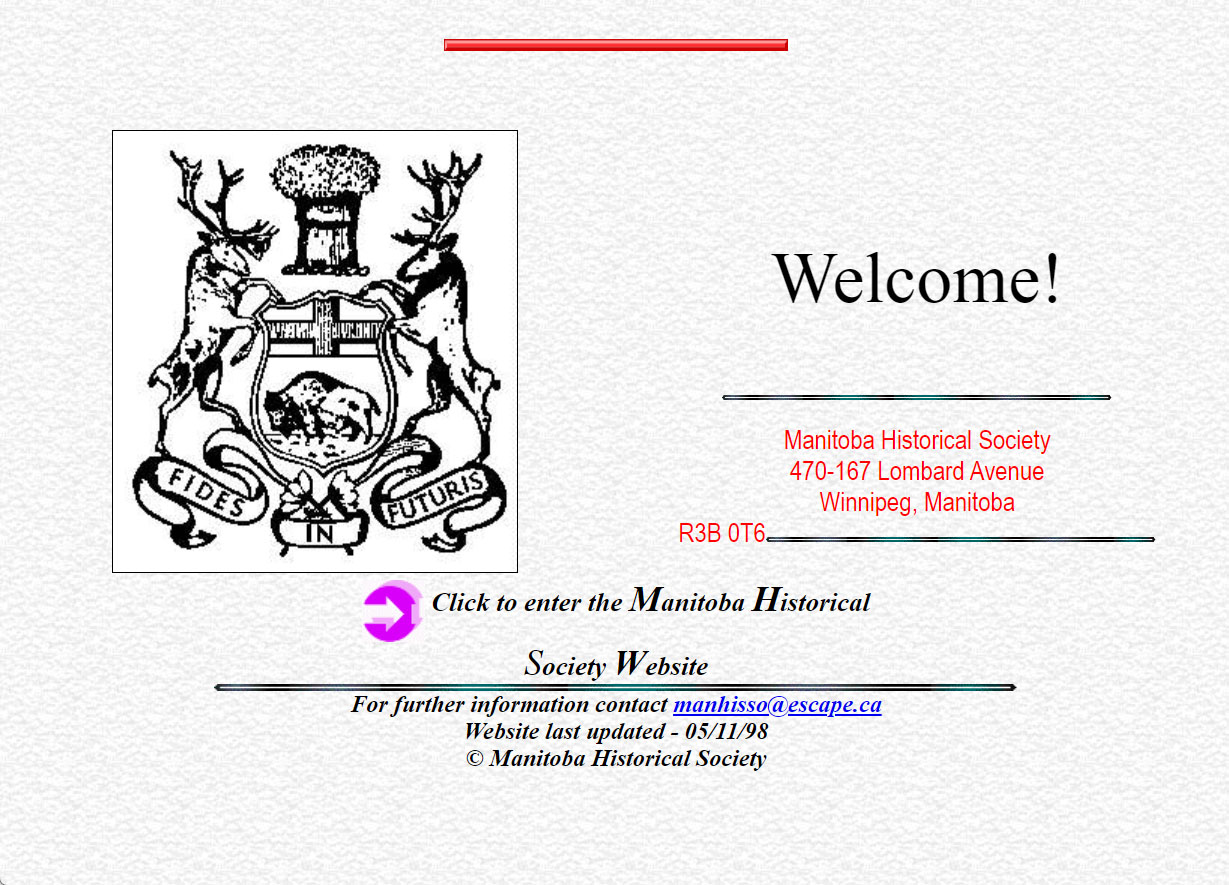The new MHS website, created for us by Relish New Brand Experience, launches today at https://mhs.ca. It features a fresh new look and works well on what device you are using, whether it’s a computer, laptop, tablet, or smartphone. Keep informed on MHS events, programs, activities, and research. Subscribe to our journal Prairie History. Donate and help us to sustain Western Canada’s oldest organization devoted to preservation and promotion of history. Browse our archive of thousands of pages of information on all facets of Manitoba history.
When our website launched in late 1998, it was one of the earliest historical websites on the newly established Internet. You can see what it looked like in the Internet Archive. (https://web.archive.org/web/19981206175228/http://www.mhs.mb.ca) Complete with cheesy fonts and animated graphics, it was not much more than an online brochure for the MHS, telling the world a little bit about what we did. It provided no historical information. That would come years later.
Jump ahead to 2002. I had joined the MHS Council and, being somewhat technologically capable, I was asked to become the Webmaster. I saw a real opportunity to expand the website so, in March 2002, I presented a detailed proposal to the Council for a complete revamp.
The new website would have five main areas. The first would be the “home page” where visitors would arrive when they typed our address (www.mhs.mb.ca) into their browser. It would provide basic information about the MHS and provide links to the other areas. The “news” area would contain frequently updated general information, including newsletters, links to other website pertinent to Manitoba history, exhibits and other special features of short duration, and could eventually have historical quizzes, questionnaires, and historical news. The “info” area could contain less frequently updated information on such topics as the MHS mission statement, contact information for MHS volunteers and staff, lists of committees, fundraising, descriptions of our publication (not the actual contents), information on award programs, and slow-refresh materials such as helpful hints for Manitoba tourists, a virtual tour of the MHS’ flagship museum, Dalnavert, and a Manitoba historical timeline. The fifth “docs” area would contain digital versions of our printed documents, including back issues of our very first one starting in the 1880s, the MHS Transactions, and carrying on to Manitoba Pageant, and Manitoba History. It would also contain “born digital content” (that is, having no counterpart in the physical world) such as historical articles, finding aids, and commentaries. Looking back on it now, I am surprised at how faithfully the first versions of the website hewed to that basic specification.
The realities and limitations of the Internet did constrain things somewhat. For example, in those days, there were no Content Management Systems (CMSs) such as WordPress (used in our new website) to do sophisticated formatting of text and graphics. The entire website was written in HyperText Markup Language (HTML). There was, however, a technology called Server Side Includes (SSI) that made it easier to have a consistent look-and-feel to the website, and that allowed us to make a single change that would affect the entire website. See this version here. https://web.archive.org/web/20030216004230/http://mhs.mb.ca
One of the first things we began to do with the website was to add digital content. We received grants to hire students to scan each page of each publication, then use Optical Character Recognition (OCR) software to convert the scan into editable text. The quality of that early OCR software was terrible with the result that it introduced all kinds of misspellings into the text. We fixed most of them through the ensuing years but, occasionally, we find one here and there. Our old publications contained lots of great information that was available nowhere else. But they were nearly impossible to read unless you had access to bound copies in academic libraries. Now, being online (and, even more valuably, searchable by AltaVista and other search engines of the time – Google was still years in the future), they could enjoy a whole new level of usefulness.
The next major advance in development of the MHS website came as the contents of our publications began to appear online. In many cases, the authors of those publications were long gone. Yet, I thought they had made significant contributions to our understanding of Manitoba history. Shouldn’t we remember them in some way? I started putting together brief biographies of such early MHS authors and volunteers, people like George Bryce (1844-1931), Charles Napier Bell (1854-1936), and David Stewart (1874-1937). Initially, there was just a tiny collection of biographies but, as it grew, it became increasingly comprehensive and useful. It needed a name. One day, as my mind wandered during a snowmobile ride across Lake Manitoba, it came to me: Memorable Manitobans. I’ve always been a fan of alliteration; maybe it has something to do with my name? I liked “Memorable” because it did not imply any judgement about the people included. Some of them might be real scoundrels, yet remembering them could serve as a valuable lesson of what NOT to do.
Today, the website comprises over 30,000 individual pages of information with vast numbers of cross-references between pages. So, for example, one can start with a Memorable Manitoban and click on links to places they lived and worked, and learn about the history of communities, businesses, organizations, and lots more. Unfortunately, the website was limited by the technology used to create it 21 years ago. If someone complains that the website looks like something from the 2000s, there’s a good reason. Changing it will be a long-term project, due to the large number of files that must be converted. I expect it will take years.
But every journey starts with a first step, and our beautiful new website is that step. It provides all the front-facing aspects of the MHS, presenting us to the world in ways that will hopefully entice you to support us. It will automate functions, such as processing of new memberships and renewals, that have previously consumed far too much time for our busy office staff. It enables us to share stories such as this one, in what we hope will be an engaging and informative way. Most importantly, I think, the website works on whatever device you use, no matter how large or small. Whether you are viewing it from the comfort of your home or on a smartphone carried outdoors, the MHS will be there, ready to share information about this great province of Manitoba.

